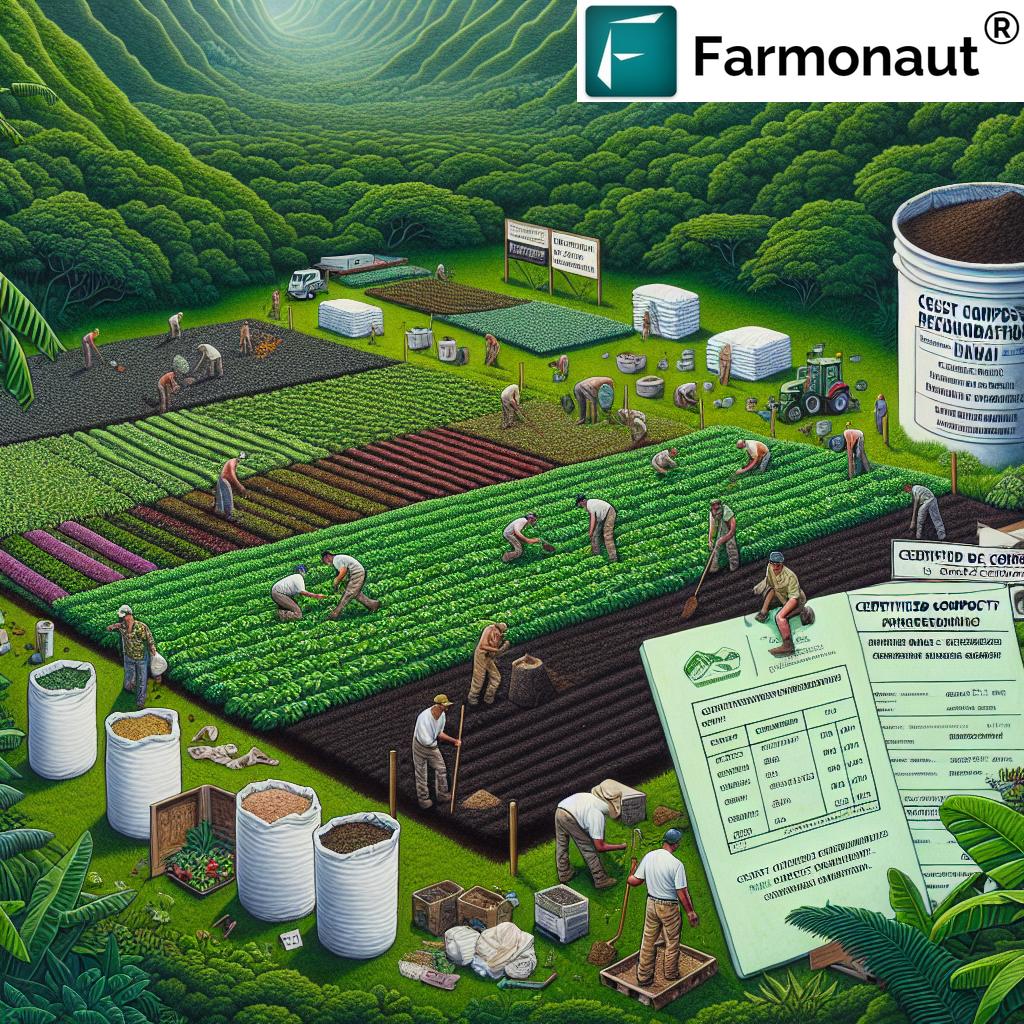California High-Speed Rail: 7 Impacts on Agriculture
“California High-Speed Rail will impact over 1,500 acres of farmland, prompting major land conservation initiatives statewide.”
“Urban forestry efforts linked to the rail project aim to plant over 5,000 new trees along its route for restoration.”
- Summary: California High-Speed Rail’s Implications for Agriculture
- Project Overview: California High-Speed Rail in Context
- California High-Speed Rail: 7 Key Impacts on Agriculture
- Environmental Mitigation and Restoration Initiatives
- Economic Impact of Transportation Projects on Farming
- Land Acquisition Challenges for Infrastructure Projects
- Comparative Impact Table: CAHSR’s Agricultural Effects
- The Role of Farmonaut in Sustainable Agriculture Monitoring
- FAQ: California High-Speed Rail and Agriculture
- Conclusion
Summary: California High-Speed Rail’s Implications for Agriculture, Farming, and Forestry
The California High-Speed Rail project, initiated in 2008, stands as the most ambitious public transportation infrastructure initiative in the state’s history. Geared towards linking San Francisco with Los Angeles—and passing through great agricultural hubs like Fresno, Bakersfield, and the Central Valley—this project represents a turning point for Californian agriculture, land conservation, and urban forestry. Its route, outlined for efficiency and connectivity, inevitably intersects California’s vital farming and forestry sectors.
While benefits include reduced carbon emissions, infrastructure upgrades, and more equitable access to mobility for disadvantaged communities, agricultural land acquisition, and conversion pose serious questions regarding sustainable land management, environmental mitigation, and resource allocation. California High-Speed Rail impact on agriculture is therefore profound—not just as a challenge, but as an opportunity to lead the U.S. in integrating large-scale infrastructure development with farmland preservation initiatives, habitat restoration in agricultural regions, and renewable energy in public transportation.
Project Overview: California High-Speed Rail in the Context of Agricultural Conservation
The California High-Speed Rail Authority (CHSRA) envisions a network that revolutionizes how Californians connect between cities. With major stops at San Francisco, Los Angeles, Fresno, and Bakersfield, the route traverses some of the world’s most productive farmland—notably, the Central Valley. As a result, the rail’s construction and ongoing operations require careful negotiation of conflicting interests:
- Efficient transportation development
- Protection of highly valuable farm and agricultural land
- Environmental mitigation for habitat and air quality
- Equity for affected communities, including disadvantaged counties like Madera and Merced
Strategic settlements and mitigation measures are central to balancing these goals. Key elements of the Authority’s approach include:
- Agricultural Conservation Easements: Working with the Department of Conservation, the Authority purchases conservation easements to safeguard lands from future non-agricultural development.
- Settlement Agreements: Collaboration with local bureaus, notably the Madera County Farm Bureau and Merced County Farm Bureau, to create a $4 million fund for land management and agricultural preservation initiatives.
California High-Speed Rail: 7 Key Impacts on Agriculture
Below, we examine in detail the seven major impacts of the California High-Speed Rail on agriculture, land conservation, and environmental sustainability, supported by the latest environmental mitigation for transportation projects standards.
- Direct Agricultural Land Loss & Changes in Land Use
- Conservation Easements and Farmland Preservation Initiatives
- Habitat Restoration & Biodiversity Support
- Urban Forestry Programs California: Carbon Sequestration & Air Quality
- Economic Impact of Transportation Projects on Farming
- Land Acquisition Challenges for Infrastructure
- Renewable Energy Integration & Climate Stewardship
1. Direct Agricultural Land Loss & Land Use Change
The California High-Speed Rail route slices through over 1,500 acres of Central Valley farmland—a region that hosts some of the most productive agriculture on the planet. The necessary acquisition and conversion of land for rail infrastructure underpins the state’s most pressing land conservation debates, highlighting the ongoing tension between infrastructure development in Central Valley and the preservation of irreplaceable farm and forest resources.
- Estimated Area Affected: 1,500+ acres of prime farmland
- Short-Term Effect: Active farmland disrupted, landowners compensated, local economies stressed during construction
- Long-Term Effect: Permanent land use shift, with agricultural output reductions unless offset by robust conservation programs
2. Conservation Easements and Farmland Preservation Initiatives
Responding to these challenges, the Authority—together with local stakeholders—is leveraging farmland preservation initiatives California-wide through strategic agricultural conservation easements. These agreements ensure that remaining lands are permanently preserved for future agricultural use, shaping a sustainable future, even as critical routes traverse the Central Valley.
- Example: Madera and Merced County settlement agreements securing permanent agricultural conservation status on select parcels
- Fund Support: $4 million agricultural and land management fund
3. Habitat Restoration & Biodiversity in Agricultural Regions
Environmental mitigation efforts have seen the restoration of nearly 3,000 acres of diverse habitat, much within or near existing agricultural areas. These actions—mandated by state and federal authorities—create synergistic opportunities to enhance restoration of natural plant and animal communities while achieving agricultural productivity.
- Environmental Mitigation: Over 2,900 acres of habitat restoration in agricultural regions
- Long-Term Effect: Improved ecosystem health, pollinator presence, and sector resilience
4. Urban Forestry Programs California: Carbon Sequestration and Air Quality
Recognizing the importance of urban forestry, the project not only compensates for lost forestry assets but also delivers forward-thinking environmental stewardship. Over 7,000 urban trees have already been planted (with plans for thousands more), absorbing substantial volumes of carbon dioxide annually, boosting air quality, and enriching green spaces within affected cities and communities.
- Cities Impacted: San Francisco, Los Angeles, Fresno, Bakersfield, others along the route
- Key Benefit: Long-term carbon sequestration plus environmental and community health
5. Economic Impact of Transportation Projects on Farming
The project’s economic impact on farm and forestry industries is multifaceted. While some farms lose land and production in the short term, others benefit from job creation, infrastructure improvements, and expanded market reach due to better transportation.
- Economic Output: Up to $13.7 billion generated, over half invested in disadvantaged communities
- Jobs: Over 92,000 job-years created
- Long-Term Effect: Improved logistics may reduce costs of agricultural products and increase access to urban markets
We recommend advanced crop monitoring and management solutions to enhance the sustainability of your farm in the face of changing infrastructure.
Explore our large-scale farm management dashboard for streamlined agricultural knowledge and increased yields through satellite-based monitoring.
6. Land Acquisition Challenges for Infrastructure Projects
Securing large swathes of farmland has caused legal disputes and delays, particularly with landowners and agricultural organizations concerned about their livelihoods and regional land management practices. The process highlights how essential a transparent, ethical, and collaborative approach to land acquisition is for securing community trust and project success.
- Legal Challenges: Ongoing disputes in Central Valley counties
- Solution: Mediation and settlements funded by targeted support programs
7. Renewable Energy Integration and Climate Stewardship
The CAHSR is designed to operate on 100% renewable energy, aligning the state’s signature infrastructure project with sustainability and environmental stewardship. Its photovoltaic and battery storage installation is expected to provide over 35 MW of clean power and store up to 140 MWh, supporting a paradigm shift in public transportation that sets a standard nationwide.
- Climate Action: Reduces transportation emissions, supports California’s clean energy mandates
- Benefit: Signals commitment to environmental leadership, benefitting agriculture through cleaner air and lessened climate impacts
Environmental Mitigation and Restoration Initiatives for Transportation Projects
Modern transportation projects like CAHSR cannot thrive without robust environmental mitigation. The Authority’s mitigation framework is focused on minimizing harm to agriculture and forestry, while maximizing benefits for habitat restoration, urban forestry, and land conservation.
Key Environmental Mitigation Strategies
-
Strategic Farmland Conservation:
The Authority guarantees that for each acre of agricultural land permanently converted for rail use, a corresponding conservation easement is placed on similarly productive farmland elsewhere. This secures the continued viability of the overall agricultural sector and establishes precedents for integrating infrastructure with conservation. -
Settlement-Funded Agricultural Support:
Through settlement with farming groups, investment in dedicated land management funds builds resilience for disadvantaged communities, ensuring ongoing agricultural viability and adaptation to changing land use. -
Habitat and Urban Tree Planting:
Restoration of thousands of acres and proactive urban forestry programs California, such as the planting of over 7,000 new trees (with a 5,000 tree goal along the main rail route), reduce ecological disruption and sequester carbon, improving the agricultural environment. -
Renewable Energy Integration:
Incorporating solar and battery technologies in the rail’s operation directly reduces the carbon footprint of passenger and freight transport, benefitting nearby farms through cleaner air and a healthier climate.
Economic Impact of Transportation Projects on Farming and Forestry
The long-term economic implications for California’s farming and forestry sectors are plural:
- Job Creation: Construction and maintenance generate thousands of positions, many accessible to local and disadvantaged communities.
- Increased Output: Local businesses benefit from improved access during and after construction, with a resultant boost in demand for agricultural goods and services.
- Market Access: Once operational, farmers near Fresno, Bakersfield, and the Central Valley gain in logistical efficiency—key for perishable produce.
- Infrastructure Upgrades: The rail catalyzes region-wide infrastructure development, such as upgraded rural roads, bridges, and transportation nodes.
For farming operations seeking to quantify and monitor their own carbon footprint,
Farmonaut’s real-time carbon footprinting dashboard puts powerful, easy-to-use environmental data at your fingertips, supporting informed decisions and making it easier to comply with state and federal climate mandates.
Land Acquisition Challenges for Infrastructure: Legal and Economic Context
No discussion of the California High-Speed Rail impact on agriculture is complete without a clear-eyed analysis of the many land acquisition challenges and related controversies:
- Legal Disputes: Court battles with landowners and farm groups in Madera and Merced counties threaten to slow the project, increase costs, and complicate settlements.
- Compensation and Equity: Ensuring fair payment for acquired lands and minimizing harm to disadvantaged communities demands transparency and thorough community engagement.
- Cost Overruns: The original project estimate of $33 billion has ballooned to over $106 billion, with funding gaps and possible loss of over $4 billion in federal support jeopardizing future mitigation and conservation efforts.
- Political Volatility: Changes in federal administration and policy uncertainty can disrupt funding, delay completion, and obscure the lines between short-term pain and long-term public benefit.
For farms exposed to climate and legal uncertainties,
Farmonaut’s satellite-based crop insurance and loan verification service streamlines access to financing and reduces risk, ensuring swift, compliance-ready claim validation—no matter the project’s pace or scope.
Comparative Impact Table: Seven Key Effects of California High-Speed Rail on Agriculture
| Impact Category | Estimated Area Affected (acres) | Environmental Mitigation Measures | Short-Term Effect | Long-Term Effect |
|---|---|---|---|---|
| Land Use Change | 1,500+ | Ag. Conservation Easements, Compensation | Farmland loss, increased stress for landowners | Permanent land use conversion; potential ag. output reduction |
| Conservation Easements | 1,500+ (protection elsewhere) | Permanent legal protection of ag. land | Negotiation with stakeholders, partial offset of land loss | Preservation of prime farmland for future generations |
| Habitat Restoration | 2,972+ | Revegetation, wildlife habitat creation | Disturbed ecosystems during construction | Biodiversity improvement, pollinator support |
| Urban Forestry Programs | 5,000+ trees (planned/ongoing) | Tree planting, urban cooling, carbon sequestration | Construction in urban/edge areas | Greener communities, cleaner air, long-term sequestration |
| Economic Output | — | $4M land mgmt. fund, job creation | Short-term employment, economic boost for locals | New markets, improved access, sustainable rural economies |
| Land Acquisition Challenges | Thousands (valuation ongoing) | Legal settlements, mediation, compensation | Delays, stress for affected communities | More structured, equitable land use policy |
| Renewable Energy Integration | — | 35+ MW PV, 140 MWh battery | Construction emissions, supply chain adjustment | Long-term emissions drop, climate leadership for ag./public trans. |
The Role of Farmonaut in Sustainable Agriculture Monitoring
As agricultural land conservation and infrastructure projects reshape California, monitoring and adapting to real-time environmental changes is essential. Farmonaut offers technology that puts rapid, science-backed data at the service of landowners, farmers, and policymakers:
- Satellite-Based Crop Health Monitoring: Assess vegetation health, soil moisture, and more, helping farms respond to construction impacts and conservation measures.
- AI-Based Advisory Systems: Jeevn AI delivers dynamic advice for resource management, supporting better decisions during times of major infrastructure development.
- Blockchain Traceability: Track field products from seed to shelf for robust, fraud-proof supply chain analytics and supply chain transparency.
- Fleet and Resource Management: Manage agricultural logistics efficiently, particularly during harvest or when routes are rerouted due to transportation construction. Fleet Management solutions empower even the largest agribusiness to reduce costs and improve compliance.
We’re committed to empowering farmers and agribusinesses facing land conversion and environmental change by making precision agriculture more accessible, affordable, and impactful—regardless of infrastructure shifts.
Developers and technology partners can connect directly to our satellite/weather API or review developer documentation here for integration flexibility at scale.
“California High-Speed Rail will impact over 1,500 acres of farmland, prompting major land conservation initiatives statewide.”
“Urban forestry efforts linked to the rail project aim to plant over 5,000 new trees along its route for restoration.”
FAQ: California High-Speed Rail, Agriculture, and Conservation
The primary strategy is the use of agricultural conservation easements, under which landowners voluntarily commit to keeping their lands in agricultural use. These conservation agreements are legal and permanent, ensuring that even as some land is converted, an equal or greater area is preserved for future farming.
Q2: How does urban forestry relate to high-speed rail?
Urban forestry programs in California tie directly into the project’s environmental mitigation by planting thousands of trees along and near the rail route. This helps sequester carbon, cools urban microclimates, and improves quality of life for communities in San Francisco, Los Angeles, and other project-adjacent cities.
Q3: How does Farmonaut support landowners during major infrastructure projects?
While we do not regulate or directly negotiate land deals, our tools provide satellite-based monitoring, AI analytics, and blockchain-based traceability solutions to help landowners document crop health, optimize resource use, and access financing or insurance. This is crucial for managing farms impacted or rerouted by large-scale infrastructure.
Q4: What are the short-term and long-term agricultural impacts of CAHSR?
- Short-term: Land disturbance, construction-related disruption, temporary economic stress on certain communities.
- Long-term: Permanent loss of some agricultural land, but with strong mitigation through easements and restoration, plus climate and economic benefits due to improved infrastructure and lower emissions.
Q5: How does renewable energy in public transportation influence agricultural sectors?
By powering CAHSR with renewable energy (solar, battery), the entire region benefits from reduced air pollution, lower carbon emissions, and a healthier climate—conditions essential for robust, sustainable agricultural production.
Q6: Where can I get more technical information or integrate Farmonaut solutions?
Click for Farmonaut’s advanced crop plantation/forest advisory and monitoring platform: Get started here. For API details, refer to our API page or review our developer documentation.
Conclusion
The California High-Speed Rail impact on agriculture is profound and multi-dimensional, spanning land conversion, conservation initiatives, habitat restoration, urban forestry, and the integration of renewable energy. Central Valley’s iconic farming sector, alongside San Francisco, Los Angeles, Fresno, and Bakersfield, sits at the crossroads of economic opportunity and environmental responsibility. While legal and financial challenges persist, the commitment to long-term sustainability and balanced land management is clear.
With fast-evolving technology from providers like Farmonaut, farmers and landowners gain direct control over data-driven insights for field management, resilient planning, and transparent traceability—empowering California’s agricultural landscape to thrive amid bold transportation innovation.
Farmonaut is dedicated to supporting the evolving needs of the agricultural community by providing affordable, advanced solutions for monitoring, managing, and future-proofing farmlands—wherever infrastructure reshapes the landscape.
Try our platform today—web, Android, or iOS.
















